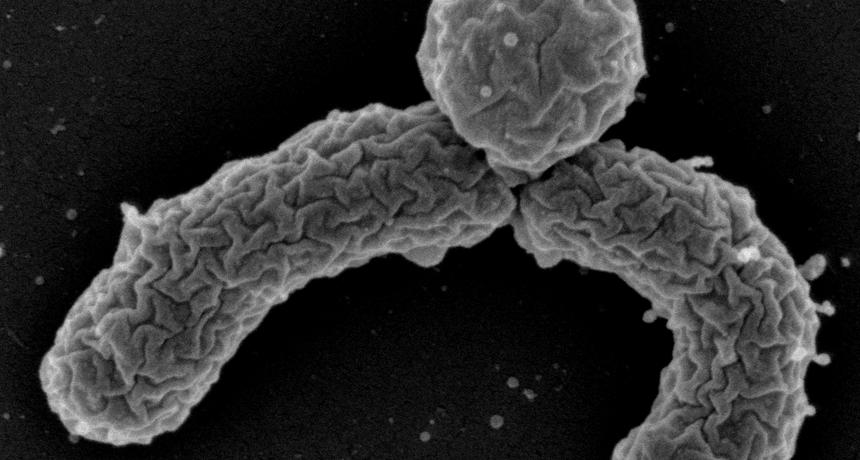New germ fighter turns up in dirt
A compound found in soil may fight off bacteria that cause dangerous infections

A microbe, shown here, can make what looks to be a new antibiotic. In lab tests, the compound it created killed germs that cause diseases such as tuberculosis.
WILLIAM FOWLE/NORTHEASTERN UNIV.
A new drug for treating dangerous bacteria might be right underfoot. Really.
Researchers found a compound in soil that acts as an antibiotic. That means it kills bacteria. The compound is called teixobactin (TIKES-so-BAK-tin). In the lab, it wiped out bacteria that cause dangerous infections in people. These included anthrax, tuberculosis (TB) and strep.
Also important, the potential drug seems safe for use in animals. In mice infected with the bacteria that cause strep throat, the chemical killed the germs without harming the animals. The compound even killed bacteria that had become resistant to other antibiotics. (Here, resistance means the drug no longer kills germs. When that happens, doctors can no longer rely on it to fight disease.)
Resistance is making many antibiotics useless. This is proving especially true for drugs that had been used for decades or more. Indeed, more and more bacteria around the world are becoming resistant to antibiotics. And when infected with those germs, people may get very sick. Large numbers of people now die from diseases that antibiotics once cured. TB is among them. In response, drug companies are looking for new treatments.
Teixobactin works by harming a germ’s ability to build its cell wall, notes Kim Lewis. He is a biochemist at Northeastern University in Boston, Mass. With its cell wall weakened, the germ loses its defenses and dies, Lewis’s team showed. It reported its findings January 22 in Nature.
Isolating the potential ‘drug’
To stay alive, many bacteria in soil naturally make antibiotics — compounds that kill other bacteria. That’s why scientists had looked for antibiotics in soil before. But those researchers were never able to produce the germ-fighting compounds using traditional lab methods.
Lewis and his team tried something different. They worked with bacteria called Eleftheria terrae (EL-ef-THEER-ee-ah TAIR-ay).These microbes naturally live in soil. So Lewis’ team decided to grow them in dirt. And when they did, these bacteria made their chemical weapon: teixobactin. Once a big colony of the germs had made lots of the chemical, Lewis’ group separated it from the soil.
Teixobactin looks promising as a new germ-fighting drug. But more work is needed before it might be ready for doctors to use, Lewis reported at a press conference. It must be tested for at least another two years in the lab, he said — in animals. If all goes well, tests in people then may begin. It will be at least five or six years before a drug made from this chemical might be available, Lewis said.
But he thinks his team’s hard work will pay off. “Teixobactin will represent a new class of antibiotics,” he says. And because this compound is so different from other antibiotics, he thinks bacteria will not quickly become resistant to it.
Gerard Wright, a biochemist at McMaster University in Hamilton, Ontario, was not involved in the new study. He wrote a commentary on the new findings that also appeared in Nature. The new data, he says, “offer hope that innovation and creativity can combine to solve the antibiotics crisis.”
Power Words
(for more about Power Words, click here)
anthrax A bacterial infection of sheep and cattle that can also be transmitted to humans.
antibiotic A germ-killing substance prescribed as a medicine (or sometimes as a feed additive to promote the growth of livestock). It does not work against viruses.
bacterium (plural bacteria) A single-celled organism. These dwell nearly everywhere on Earth, from the bottom of the sea to inside animals.
cell The smallest structural and functional unit of an organism. Typically too small to see with the naked eye, it consists of watery fluid surrounded by a membrane or wall. Animals are made of anywhere from thousands to trillions of cells, depending on their size.
compound (often used as a synonym for chemical) A compound is a substance formed from two or more chemical elements united in fixed proportions. For example, water is a compound made of two hydrogen atoms bonded to one oxygen atom. Its chemical symbol is H2O.
germ Any one-celled microorganism, such as a bacterium, fungal species or virus particle. Some germs cause disease. Others can promote the health of higher-order organisms, including birds and mammals. The health effects of most germs, however, remain unknown.
infection A disease that can spread from one organism to another.
microbe (short for microorganism ) A living thing that is too small to see with the unaided eye, including bacteria, some fungi and many other organisms such as amoebas. Most consist of a single cell.
resistance (as in drug resistance) The loss of effectiveness of a drug to cure a disease, usually a microbial infection.
strep Short for streptococcus, it’s a family of bacteria, some of which can cause a fever, swollen tonsils and a severe sore throat, especially in children.
tuberculosis Also known as TB. This bacterial disease causes unusual growths in the lungs or other tissues. Untreated, it can kill. The infection usually spreads when a sick individual coughs (or talks, sings or sneezes), spewing germs into the air.







